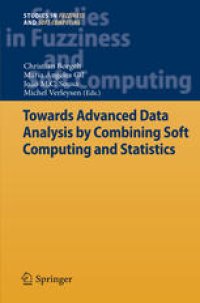
Ebook: Towards Advanced Data Analysis by Combining Soft Computing and Statistics
- Tags: Computational Intelligence, Probability and Statistics in Computer Science, Data Mining and Knowledge Discovery, Simulation and Modeling
- Series: Studies in Fuzziness and Soft Computing 285
- Year: 2013
- Publisher: Springer-Verlag Berlin Heidelberg
- Edition: 1
- Language: English
- pdf
Soft computing, as an engineering science, and statistics, as a classical branch of mathematics, emphasize different aspects of data analysis.
Soft computing focuses on obtaining working solutions quickly, accepting approximations and unconventional approaches. Its strength lies in its flexibility to create models that suit the needs arising in applications. In addition, it emphasizes the need for intuitive and interpretable models, which are tolerant to imprecision and uncertainty.
Statistics is more rigorous and focuses on establishing objective conclusions based on experimental data by analyzing the possible situations and their (relative) likelihood. It emphasizes the need for mathematical methods and tools to assess solutions and guarantee performance.
Combining the two fields enhances the robustness and generalizability of data analysis methods, while preserving the flexibility to solve real-world problems efficiently and intuitively.
Soft computing, as an engineering science, and statistics, as a classical branch of mathematics, emphasize different aspects of data analysis.
Soft computing focuses on obtaining working solutions quickly, accepting approximations and unconventional approaches. Its strength lies in its flexibility to create models that suit the needs arising in applications. In addition, it emphasizes the need for intuitive and interpretable models, which are tolerant to imprecision and uncertainty.
Statistics is more rigorous and focuses on establishing objective conclusions based on experimental data by analyzing the possible situations and their (relative) likelihood. It emphasizes the need for mathematical methods and tools to assess solutions and guarantee performance.
Combining the two fields enhances the robustness and generalizability of data analysis methods, while preserving the flexibility to solve real-world problems efficiently and intuitively.
Soft computing, as an engineering science, and statistics, as a classical branch of mathematics, emphasize different aspects of data analysis.
Soft computing focuses on obtaining working solutions quickly, accepting approximations and unconventional approaches. Its strength lies in its flexibility to create models that suit the needs arising in applications. In addition, it emphasizes the need for intuitive and interpretable models, which are tolerant to imprecision and uncertainty.
Statistics is more rigorous and focuses on establishing objective conclusions based on experimental data by analyzing the possible situations and their (relative) likelihood. It emphasizes the need for mathematical methods and tools to assess solutions and guarantee performance.
Combining the two fields enhances the robustness and generalizability of data analysis methods, while preserving the flexibility to solve real-world problems efficiently and intuitively.
Content:
Front Matter....Pages 1-7
Arithmetic and Distance-Based Approach to the Statistical Analysis of Imprecisely Valued Data....Pages 1-18
Linear Regression Analysis for Interval-valued Data Based on Set Arithmetic: A Review....Pages 19-31
Bootstrap Confidence Intervals for the Parameters of a Linear Regression Model with Fuzzy Random Variables....Pages 33-42
On the Estimation of the Regression Model M for Interval Data....Pages 43-52
Hybrid Least-Squares Regression Modelling Using Confidence Bounds....Pages 53-63
Testing the Variability of Interval Data: An Application to Tidal Fluctuation....Pages 65-74
Comparing the Representativeness of the 1-norm Median for Likert and Free-response Fuzzy Scales....Pages 75-86
Fuzzy Probability Distributions in Reliability Analysis, Fuzzy HPD-regions, and Fuzzy Predictive Distributions....Pages 87-98
SAFD — An R Package for Statistical Analysis of Fuzzy Data....Pages 99-106
Statistical Reasoning with Set-Valued Information: Ontic vs. Epistemic Views....Pages 107-118
Pricing of Catastrophe Bond in Fuzzy Framework....Pages 119-136
Convergence of Heuristic-based Estimators of the GARCH Model....Pages 137-150
Lasso–type and Heuristic Strategies in Model Selection and Forecasting....Pages 151-163
Streaming-Data Selection for Gaussian-Process Modelling....Pages 165-176
Change Detection Based on the Distribution of p-Values....Pages 177-190
Advanced Analysis of Dynamic Graphs in Social and Neural Networks....Pages 191-203
Fuzzy Hyperinference-Based Pattern Recognition....Pages 205-222
Dynamic Data-Driven Fuzzy Modeling of Software Reliability Growth....Pages 223-240
Dynamic Texture Recognition Based on Compression Artifacts....Pages 241-252
The Hubness Phenomenon: Fact or Artifact?....Pages 253-266
Proximity-Based Reference Resolution to Improve Text Retrieval....Pages 267-278
Derivation of Linguistic Summaries is Inherently Difficult: Can Association Rule Mining Help?....Pages 279-290
Mining Local Connectivity Patterns in fMRI Data....Pages 291-303
Fuzzy Clustering based on Coverings....Pages 305-317
Decision and Regression Trees in the Context of Attributes with Different Granularity Levels....Pages 319-330
Stochastic Convergence Analysis of Metaheuristic Optimisation Techniques....Pages 331-342
Comparison of Multi-objective Algorithms Applied to Feature Selection....Pages 343-357
Back Matter....Pages 359-375
....Pages 0--1